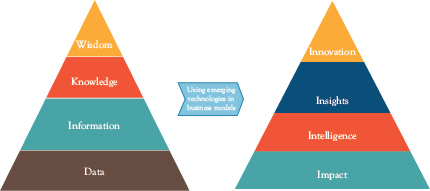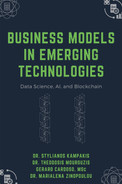We are currently drowning in data! The data management pyramid, also known as the DIKW pyramid, examines the hierarchical relationship between data, information, knowledge, and wisdom as shown in Figure F.1. We note that there is a distinct hierarchy in the level of analysis of data. If we translate this for the business of tomorrow, we could have the pyramid showing impact at the base, followed by intelligence that leads to insights and finally innovation (Figure F.2). The first level would include any data that has an Impact on the business. The analysis of that data in depth would yield Intelligence that can be collated into valuable Insights and used to inform the next level of business Innovation.
Currently, we have analytics tools available that can help analyze data to obtain basic information. But unfortunately, that is not always enough. Discovering that the target audience is 21 to 24-year-olds living in the United Kingdom and using at least two social media platforms daily is an example of the basic information we can pull from data. However, using this kind of information as the basis for business decisions can be like trying to analyze a book’s storyline and characters based on two or three chapters.
Reaching the next level of data analysis is not easy. Getting valuable insights from data is a Herculean task. We often lack the expertise to do so, and that is because insights are not reported in a tool or presented in a report somewhere. To convert information into actionable insights, one needs to know how to collect data from multiple sources and then connect the dots that translate into meaningful knowledge. And we need true insights to be able to utilize data. The growth of the Internet of Things (IoT) and 5G technology will see more connected devices than ever before and the flow of real-time data as a result. As consumers begin to rely on wearables while becoming more immersed in digital experiences, we will have to find new ways to measure the impact that those experiences leave. New metrics will emerge as vital in understanding behavior patterns, and we will have to find more advanced ways for understanding what the data is saying.

Figure F.2 Business analytics pyramid
The consensus in the business world today is that we need to be better at analyzing our data. The issue at hand is how? Data scientists today work with data to create these insights, and businesses benefit from clear and actionable results from data analysis. However, this will not be possible when we consider the volume and sources of the data we will deal with. To take the business to that next level of data analysis, we can turn to emerging technologies, specifically artificial intelligence (AI).
AI can help solve the problem of analyzing data in motion—this is data coming in real time—as it can process information and analyze thousands of pieces of information drawn from multiple levels and from varied sources, which can yield “live” results within seconds. Therefore, implementing AI-powered insights can change the way we do marketing and how we make strategic decisions.
We do, however, also need to make sure the results are explainable. A business needs to understand how the intelligence was used to give the resulting insights. We need a clear concept of why we are getting these results.
Explainable AI for business will be an important consideration in the implementation process of new business models. This means understanding the connections and associations that link the information and why the AI system saw them as significant.
It will be essential to ensure there are no broken links in the data and information that is used or misalignment in the objectives that the AI applies. It will also be valuable from an ethical point of view to ensure that there is accountability and to avoid bias in the decision-making process when business insights are based on AI analysis.
As we find ourselves at the dawn of the Fourth Industrial Revolution, we know that the line between the physical, digital, and virtual worlds will become blurred as they are linked together through IoT sensors and simulators. As a result, we will become a more cyber society.
This industrial revolution is going to be more powerful than the previous ones. We are no longer dealing with just one new technology but with multiple powerful emerging technologies that are all interlinked and can work together. These technologies are just as powerful and impactful as electricity was 150 years ago or the Internet was 40 years ago. And just like when electricity and the Internet were introduced, the world will never be the same again.
This time, however, we have an entirely new phenomenon taking place. We don’t have just one, but multiple emerging technologies all introduced at once. AI, blockchain, augmented and virtual reality, and the IoT will change every aspect of life as we know it. It is predicted that it will be many times more impactful than any previous industrial revolution.
A change like that will see the introduction of new ways of doing things. It will mean new business models, communication channels, and immersive social environments. Businesses need to stay informed with the changing landscape and plan ahead. A strong understanding of the impact that these technologies will have on their customers and their business will ensure that they start to find ways to implement strategies in time.
A business that doesn’t understand customer journey analytics (2–5 years from plateau of productivity) and social analytics (less than two years from plateau of productivity), based on the Gartner Hype Cycle for Digital Marketing in 2021 (Gartner 2021), is likely to be left behind when this analysis is required to reach and understand the target audience. Real-time marketing is 5 to 10 years away, according to the same hype cycle (Gartner 2021), which indicates that businesses should know how to analyze data in real time to do real-time marketing effectively by the end of this decade. For a company to be ready to collect, secure, and analyze data on impact, we need to fully understand these technologies and their capabilities.
Data scientists have been working on understanding how businesses can utilize emerging technologies and find solutions to suggest applications and new business models that will help with the implementation and analysis. However, many companies are still in the dark, and alarm bells are ringing that time is running out. The need to evolve quickly to stay relevant in the world of tomorrow should be top on the strategic agenda.
We can visualize emerging technologies as working as the human body does. AI is the brain where information is processed and analyzed to give us knowledge and insights that lead to wisdom. Virtual reality and augmented/mixed reality are the senses—a way to see and appreciate new content and environments that immerse us into new experiences. Blockchain is our immune system—the chain of protection that secures the system. The IoT is the nervous system, where multiple sensors collect information and send it to the brain for processing. Finally, 5G is the fuel that keeps it all running—like glucose in the body. And just like our body works as one connected system, with each part relying on the other, so too do these technologies rely on each other for information, analysis, security, and fuel.
Emerging technologies will change how we communicate, work, educate, live, socialize, and do business. We can prepare by understanding the implications and working toward new business models that will inspire innovation.
—Dr. M Zinopoulou
